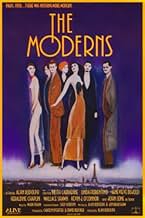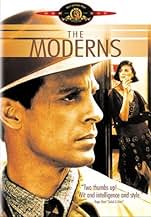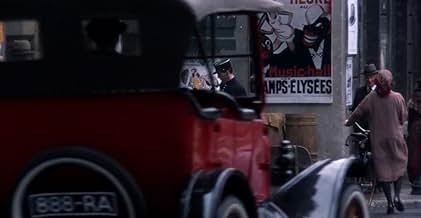NOTE IMDb
6,6/10
2,1 k
MA NOTE
Ajouter une intrigue dans votre langueA struggling artist is hired to forge paintings, causing him to cross paths with his ex-wife and her powerful new husband.A struggling artist is hired to forge paintings, causing him to cross paths with his ex-wife and her powerful new husband.A struggling artist is hired to forge paintings, causing him to cross paths with his ex-wife and her powerful new husband.
- Réalisation
- Scénario
- Casting principal
- Récompenses
- 2 victoires et 5 nominations au total
Geneviève Bujold
- Libby Valentin
- (as Genevieve Bujold)
Charlélie Couture
- L'Evidence
- (as Charlelie Couture)
Véronique Bellegarde
- Laurette
- (as Veronique Bellegarde)
Avis à la une
Rudolph sets an interesting atmosphere in this film about artists in Paris between the wars. Most of the scenes are borrowed from Hemingway's "A Movable Feast," and the dialog liberally pokes fun of the author. Some characters play better than others - Wallace Shawn's Oiseau is memorable, as is John Lone's Creepy, enigmatic part. I enjoy Carradine's artist character - though I understand that some people are rubbed the wrong way by his performance. Linda Fiorentino is somewhat annoying in her part, as is Genevieve Bujold. Still, as other comments note, the soundtrack is really quite impressive - and worth having on its own. Overall, if you like Rudolph's films, and you want to see an interesting take on some of Hemingway's autobiographical ramblings, this is a fun one to watch. This is a film that I first went to see by accident, but liked more an more as time went on - personally I put it in a class with "Diva" for atmosphere - some characters work, and others don't, and you either like the movie or you hate it. I, for one, like it.
This may not be everyone's cup of tea, but it has a genuine, unpretentious charm to it that I found appealing.
Alan Rudolph made this delightful little ode to lies, trickery and delusion on a shoestring budget. The story of a failed painter down on his luck in Paris in the 1920's who accepts a comission to forge a famous impressionist painting. The film questions what is real versus what is perceived or subjective. In a series of criss-crossing subplots and seemingly random encounters Rudolph has fun playing with the trickery of film to made some sly points about the art forms we hold dear.
The film was shot in Montreal, Canada, standing in for Paris and New York in the 1920's, with French-Canadian actors playing Parisians... The plot twists include a millionaire art collector publicly slashing a priceless painting, thinking it a forgery, while the fake painting is sent to hang in a New York museum. A Dadaist poet fakes his own death in order to attend his funeral to hear the things people will say about him. Same character, named L'Oiseau is actually an American ex-patriate named Fagelman! In a toungue-in-cheek hommage to people's perception of the period, Rudolph has Papa Hemmingway hanging-out in all the cafe's and at all the parties... He is seemingly everywhere, sipping scotch and mouthing tough-guy cliches...
But the viewer must beware of what he is watching. In a scene where Bujold's character rides in a taxi with Carradine's we are treated to lovely rear projection shots through the cab's back window of impressionist paintings of Paris at night! In another dimly lit cafe scene Rudolph chose to end the scene by panning away from the action to the bar where among the extras in period costume, two punk rockers are watching a hockey game on t.v.
Alan Rudolph made this delightful little ode to lies, trickery and delusion on a shoestring budget. The story of a failed painter down on his luck in Paris in the 1920's who accepts a comission to forge a famous impressionist painting. The film questions what is real versus what is perceived or subjective. In a series of criss-crossing subplots and seemingly random encounters Rudolph has fun playing with the trickery of film to made some sly points about the art forms we hold dear.
The film was shot in Montreal, Canada, standing in for Paris and New York in the 1920's, with French-Canadian actors playing Parisians... The plot twists include a millionaire art collector publicly slashing a priceless painting, thinking it a forgery, while the fake painting is sent to hang in a New York museum. A Dadaist poet fakes his own death in order to attend his funeral to hear the things people will say about him. Same character, named L'Oiseau is actually an American ex-patriate named Fagelman! In a toungue-in-cheek hommage to people's perception of the period, Rudolph has Papa Hemmingway hanging-out in all the cafe's and at all the parties... He is seemingly everywhere, sipping scotch and mouthing tough-guy cliches...
But the viewer must beware of what he is watching. In a scene where Bujold's character rides in a taxi with Carradine's we are treated to lovely rear projection shots through the cab's back window of impressionist paintings of Paris at night! In another dimly lit cafe scene Rudolph chose to end the scene by panning away from the action to the bar where among the extras in period costume, two punk rockers are watching a hockey game on t.v.
This is a fairly enjoyable tale set in the art world of 1920s Paris. The look of the film and the mood it creates are the most important things; far more important than the enjoyable, yet slow-moving plotline.
It is highly imaginative and its representation of icons such as Ernest Hemingway and Gertrude Stein add an extra dimension to the film.
The only true weak points are some of the dialogues between the two leads; it is sometimes out of place and almost too 'modern'!
All the performances are good but John Lone and Keith Carradine are especially suited to their parts.
It is highly imaginative and its representation of icons such as Ernest Hemingway and Gertrude Stein add an extra dimension to the film.
The only true weak points are some of the dialogues between the two leads; it is sometimes out of place and almost too 'modern'!
All the performances are good but John Lone and Keith Carradine are especially suited to their parts.
A couple years ago I saw Trouble in Mind, and was immediately absorbed in the atmospheric world the film portrayed. I have since been dying to see another movie by the same director. Well, I've just seen the Moderns, and was immediately disappointed. While the film shares the same claustrophobic tendencies of the previous work, in this one it doesn't seem as deliberate, but more a matter of budgetary restraints. I never got the feeling that I was watching Paris, or 1920's Paris, for that matter. All I got was the sensation of watching stilted actors playing dress-up. The dialogue and plot for this movie is b-movie crust, which can be good, but the dreariness of the action and the way in which the film was filmed left it almost completely vacant of any charm. Cute references to pop culture from the 20's only sounds contrived and makes the film more apparent of what it isn't. One should get the feeling one is watching the 20's unfold without the crutch of references. We are never given any reason to care for any of the actors. They are cartoonish, but not cartoonish enough for them to be relieving and enjoyable. This movie takes itself far too seriously to be enjoyed as camp, which makes scenes involving fake suicide and real suicide all the more dour. The sets are perhaps more wooden than the characters, Hart's art atrocious. Hemmingway appears as a jocular Ethan Hawke ruffian, a pale shadow compared to Hart's masculinity. Lampooning famous people can be fine, but not when the only purpose of it is to rip them off and make them a clown with no real relevance to the story. I did, however, like the portrayal of Gertude Stein as a cliquish art snob. That's a more fair assessment. To be missed or slept through.
Alan Rudolph does not make movies for everyone to see. His movies seem like personal projects that interest him at the time. Some of his movies I haven't been able to get involved in (Trixie, Mortal Thoughts, Afterglow) but with The Moderns, I was pulled in quickly. The story focuses on Keith Carradine's ex-patriot Nick Hart, a painter who has the ability to duplicate famous works of art with his brush. He's hired to create forgeries by Mademoiselle de Ville (Geraldine Chaplin).
But the story doesn't stop there. There are other ex-patriots around, including young Ernest Hemingway, comically portrayed by Kevin J. O'Connor; who is constantly drinking, philosophizing and pursuing women. It's not a flattering look at Hemingway, but somehow it adds to the whole ambience of the film and seems to ring true. And then there is Linda Fiorentino, a former lover of Nick's, and her husband, the rich and icy Bertram Stone (John Lone). The characters are odd and quirky, the story is uneven at times, and meanders a bit, but it is never boring. This movie has such style and depth that it pulls the viewer in, like we're trying to see the work that is under the painted canvas. That's what this movie is about -- the greater depth of art. What is art and what is crap? What is love and what is hate? What is real and what is illusion? As a director, Alan Rudolph pulls us along cleverly, with a hint of intrigue, the dichotomy of Nick's love and Hemingway's carousing, a taste of passion and the beauty of art. Then there are the characters who are well-layered works of art themselves. Maybe this movie isn't a masterpiece, but it leaves us chipping away at the paint trying to see what treasure is underneath. It's a movie to be enjoyed on many levels, just like a work of art.
But the story doesn't stop there. There are other ex-patriots around, including young Ernest Hemingway, comically portrayed by Kevin J. O'Connor; who is constantly drinking, philosophizing and pursuing women. It's not a flattering look at Hemingway, but somehow it adds to the whole ambience of the film and seems to ring true. And then there is Linda Fiorentino, a former lover of Nick's, and her husband, the rich and icy Bertram Stone (John Lone). The characters are odd and quirky, the story is uneven at times, and meanders a bit, but it is never boring. This movie has such style and depth that it pulls the viewer in, like we're trying to see the work that is under the painted canvas. That's what this movie is about -- the greater depth of art. What is art and what is crap? What is love and what is hate? What is real and what is illusion? As a director, Alan Rudolph pulls us along cleverly, with a hint of intrigue, the dichotomy of Nick's love and Hemingway's carousing, a taste of passion and the beauty of art. Then there are the characters who are well-layered works of art themselves. Maybe this movie isn't a masterpiece, but it leaves us chipping away at the paint trying to see what treasure is underneath. It's a movie to be enjoyed on many levels, just like a work of art.
Le saviez-vous
- AnecdotesIsabella Rossellini screen-tested to play Nathalie DeVille, but lost to Geraldine Chaplin.
Meilleurs choix
Connectez-vous pour évaluer et suivre la liste de favoris afin de recevoir des recommandations personnalisées
- How long is The Moderns?Alimenté par Alexa
Détails
Box-office
- Budget
- 3 500 000 $US (estimé)
- Montant brut aux États-Unis et au Canada
- 2 011 497 $US
- Week-end de sortie aux États-Unis et au Canada
- 20 283 $US
- 17 avr. 1988
- Montant brut mondial
- 2 011 497 $US
- Durée2 heures 6 minutes
- Couleur
- Mixage
- Rapport de forme
- 1.85 : 1
Contribuer à cette page
Suggérer une modification ou ajouter du contenu manquant

Lacune principale
By what name was Les modernes (1988) officially released in India in English?
Répondre
































